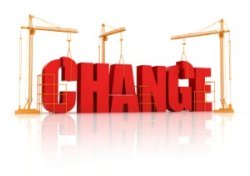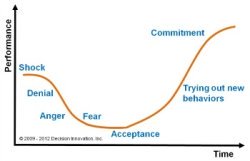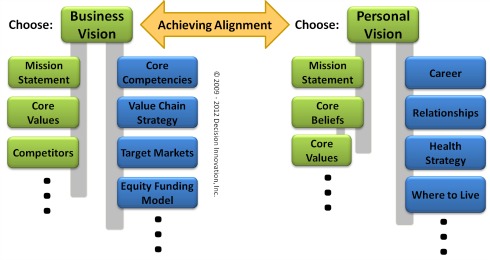Using the Connected Decisions framework to manage change and achieve alignment
 Choosing to change can be one of the most difficult decisions we make. It often requires confronting a fundamental inconsistency in beliefs that can be core to a personal or organizational identity.
Choosing to change can be one of the most difficult decisions we make. It often requires confronting a fundamental inconsistency in beliefs that can be core to a personal or organizational identity.
The ability to change can become critical to the survival and sustainability of a company. This has led to a number of change management models that have been developed to facilitate and lead needed or desired change. Well known examples include:
- John Kotter's eight step change model - Create urgency, form a guiding coalition, create a vision for change, communicate the vision, empower action on the vision, create short-term wins, build on the change, and incorporate the changes into the culture.
- Kurt Lewin's change management model - Unfreeze, change, and refreeze.
- The McKinsey 7-S model - Alignment of interdependent elements of strategy, structure, systems, shared values, skills, style, and staff.
- The ADKAR model - Sequential elements of awareness, desire, knowledge, ability, and reinforcement.
Additional models also exist for managing personal change. If you would like us to cover this topic in a future newsletter, please contact us to let us know.
A model that inherently achieves alignment
 Change management has the objective of moving an individual, team, or organization from a current state to a preferred future state. These models provide approaches to do this without explicitly addressing the fundamental component needed for change; a new or updated set of working decisions.
Change management has the objective of moving an individual, team, or organization from a current state to a preferred future state. These models provide approaches to do this without explicitly addressing the fundamental component needed for change; a new or updated set of working decisions.
Many of the elements discussed in the models are central to a Connected Decisions framework. Kotter's model relies on development of new decisions for vision and mission. The McKinsey approach recognizes the interdependence of decisions for strategy and shared values. New knowledge and skills required for decision success are suggested in the McKinsey and ADKAR models. Change completes successfully when cultural alignment is achieved and the organization operates under the new set of core beliefs.
Resistance to change arises from lack of decision alignment at either the organizational or personal level. Focusing on decisions can expose the choices that must be aligned for a change effort to be successful. Ultimately, decisions fundamental to the change effort must be reinforced with evidence that goals and success factors are being achieved for new beliefs to take hold.
Benefits from using a Connected Decisions change management model
Using the Connected Decisions framework to manage change puts focus squarely on where change will take place: the organizational and personal choices that align, generate, and promote realization of a desired future. Managing change equals managing decisions. Benefits of using this approach include:
- A model that is guided by vision and mission decisions that define the preferred future state
- A reusable structure that can separate the change project into manageable parts
- Clear evaluation criteria that can be used to define the problem to be solved and assess progress
- Inherent alignment that comes from decisions connected by requirements (see our decision model)
- Creation of knowledge (within and between decisions) needed to enable change
- A single consistent process for progressing through the change effort
- Common language for communicating success in meeting needs and desires that transcends organizational boundaries
- Change acceleration that results from intermediate choices that minimize negative consequences and maximize positive outcomes
- The ability to manage change and innovation, as well as enable collaboration, with that same model
The connected decision framework can also be used to expose the need for change by showing where the current working set of decisions will not meet goals, needs, or desires envisioned for the organization and its stakeholders.
Achieving strategic alignment
 Managing the change process plays an important role when transforming strategy. The need for quick and effective strategic alignment may be critical to organization or company survival. Change management models were developed to address challenges associated with this type of large scale change. They seek to minimize the loss in performance that comes from negative emotions characterized by the change curve (shock, denial, anger, fear).
Managing the change process plays an important role when transforming strategy. The need for quick and effective strategic alignment may be critical to organization or company survival. Change management models were developed to address challenges associated with this type of large scale change. They seek to minimize the loss in performance that comes from negative emotions characterized by the change curve (shock, denial, anger, fear).
To achieve alignment, individuals must make personal choices to adopt and align to the decisions contained in the new strategy. If vision and mission are changing, these choices include acceptance of a new organizational identity. It can be easy to see how changes of this magnitude can create conflict with personal beliefs, leading to resistance. Organizational decisions could also produce personal loss, providing another source for resistance.
Applying Connected Decisions to manage change
Decisions provide the basis for change, enabling straightforward application as a change management model.
Here are some high level steps:

- Identify the key organizational decisions that must be made to successfully reach the desired future state.
- Identify the key personal decisions that must be in alignment to generate acceptance and support for the critical organizational decisions
- Execute the decision making process for the organizational decisions that lead to the future state that is described in the vision and mission decisions
- Maximize support and lower resistance by supporting decision alternatives that accommodate key personal choices where there is no conflict
- Identify needed improvements in guiding decisions using feedback from decision implementation
- Recognize and support separations where reconciliation of organizational and personal decisions is not possible.
The Connected Decisions framework and decision making process provides the ability to address change that scales from a single decision to complete organizational transformation.
Return from Change Management Model to Decision Making Articles

